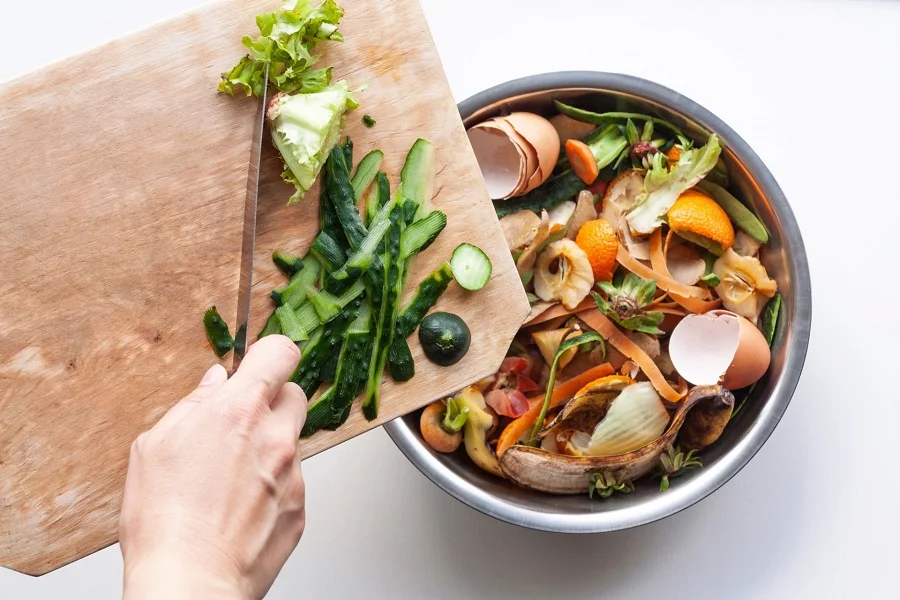Whilst I’m not going to get all ‘think about the starving kids in Africa’ on you, though I probably should, the fact is, every morsel of food leaves a trail of waste and as a society, our largest waste is food waste. Globally, we throw out one third of food produced. That’s a lot of food. Australia wastes 4,000,000 tonnes of food each year, accounting for an $8 billion loss. That’s around 20% of the food you buy; and the majority of this waste (61%,) is done by everyday households.1 That’s you, and me.
For most of us, we have all been trained to accept food waste as a ‘natural part of life, that someone else ‘out there’, ‘somewhere’, will deal with. But what sort of society could we advance if we were to not only take responsibility for the food we grew, purchased and consumed, but also for its trail of disposal? What if you were solely responsible for every piece of food scrap and waste that came into your possession, and I’m not talking about the wheelie bins out the front of your homes, no, I’m talking about utilising everyday food scraps to make delectable new meals and condiments. This in turn reduces food waste and saves significant amounts of money for households. There really is no downside to using every morsel of food – it’s a win, win for everyone.
We have put together a list of some of our favourite ways to use it all! Let’s go:
Reuse Pickle Brine:
The rush of saliva, the puckering of lips, and the crunch of pickled cucumbers, onions and lacto-fermented vegetables is undoubtedly satisfying, and the end of every joyful jar is a glut of brine (the pickling juice). Sure, you can just drink it, it’s delicious, but if you’ve had your fill, you can reuse the brine as a starter for making your very own homemade pickled vegetables, and you can pickle just about any organic scraps: carrot and beetroot tops, kale, silverbeet, broccoli and collard stems, garlic ends and skins, bean and pea ends, onion skins, celery tops, cabbage and cauliflower cores, watermelon rinds.
Dehydrate:
Dehydrate citrus peels (oranges, mandarins, pomelo, grapefruit, limes, lemons, and citron) and with their jacked-up immune-boosting vitamin C they can be used to garnish cocktails, flavour water, ground into powders to be used in baked goods, soups, sauces, marinades, infuse as a tea, not to mention added to vinegar to make a household cleaning solution (the citrus oils assists in dissolving grease and adds some antibacterial power) or you can always make the delightful and faithful marmalade jam.
Broths, Bouillons and Soups:
When the temperature dips, beloved broths, bouillons and soups make a bold and grand entrance. Flavoursome, fragrant, and gelatinous, broths are known to soothe the gut, heal joints, and deeply nourish and comfort and the best way to make these is from leftover meat and fish bones, vegetable scraps of all varieties including carrot tops, onion skins, celery leaves, ginger and turmeric skins, the often-tough outer leaves of collards, kale, cabbage, chard, and bok choy, and leftover herb stems and leaves.
Crunchy Croutons:
Crunchy croutons can be made using just about any stale bread – so simple! Simply chuck some bread in the oven for a few minutes and voilà. If you want to get a little fancy, cube the stale bread, toss them with good oil, garlic, salt, and herbs and bake until golden. Croutons can be added to soups and broths, salads and stews for added crunch, texture and flavour.
Banana Skins:
Banana skin tea for a better nights’ sleep is really a thing, and a good one at that. Consumed about an hour before bed, banana skin tea can help calm the nervous system and prepare the body for deep sleep. The steeping of banana skins draws out potassium and magnesium, both natural muscle relaxants.
Ferment Me:
The alchemy of watching fermentation on your very own kitchen bench is something close to magical and as a mode of ‘cooking’ it’s remarkably straightforward. The largely unseen, yet majestic, microbial kingdom just show up and transform the food on their own without any invitation required. These ferments are perfect for home food scraps:
Tepache: Steeped in Mayan history, and one of the easiest ferments in the world, simply add the skin, core and a little juice of a pineapple to some sweetened honey water and a few days later a fizzy pineapple beverage emerges. View our Fermented Pineapple Tepache recipe.
Beet Kvass: Beet scraps (skin, tops and bottoms), salt and water are all that are required to make an earthy kvass blood tonic. View our Beet Kvass Blood Tonic recipe.
Apple Scrap Cider Vinegar: Apple peels and cores, combined with sweetened water, make for a delicious apple scrap cider vinegar. Use it for everything from cooking, to cleaning, a hair rinse, animal care and everything in between.
Fire Cider Tonic Potion: It’s no secret that I believe in the power of a good witches’ brew and Fire Cider Tonic is mystic in its herbal reverence, which combines a vinegar (Apple Scrap Cider Vinegar above is a good idea) with the scraps of nature’s superheroes – ginger and turmeric root and skins, garlic ends and skins, chilli and jalapeño ends, horseradish tails, onion skins, leftover herbs and spices, and whatever citrus skins and flesh you have around. Simply leave on the bench for weeks or even months, strain and use as a tonic to help ward off winter colds and coughs, or it can be used all year round and is easy to incorporate into your daily diet to help boost the immune system, stimulate digestion and warm the body in teas or salad dressings. Please don’t waste the delicious strained fermented veggies, roots and herbs. You can use the strained veggies in stir-fries or spring rolls or blend them into a marinade or finishing sauce to be used in dips, salsas or conserves. It’s a zero-waste cycle. View our Fire Cider Tonic Potion recipe.
1UNEP (UN Environment Program), Food Waste Index Report 2021: https://www.unep.org/resources/report/unep-food-waste-index-report-2021
By:
Dr Sarah Lantz (PhD)
Buchi Brew Co. & Sacred Women’s Way


